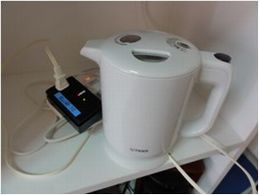August 13, 2012
Energy-On-Demand Power Control System for Smart House Energy Management
Keywords: Energy Conservation Environmental Technology University / Research institute


Smart home appliance and home appliance with a smart tap
Copyright Matsuyama Laboratory, Kyoto University
Kyoto University of Japan announced on May 22, 2012, that a research team of the Graduate School of Informatics had developed an energy-on-demand power control system that achieved the predetermined energy saving ratio, a reduction of accumulated power consumption by 10, 30, and 50 percent with the 1,200 watts instantaneous maximum electric power. In order to evaluate the effectiveness of the system, a verification test was carried out by installing the system in a condominium building.
Professor Takashi Matsuyama of the Graduate School of Informatics and his team have been studying on i-Energy (informatization of energy) and developed the new system as a part of the second stage of their study. In August 2010, as a part of the first stage of development, they established a system to make household energy consumption visible using "smart taps" with high level functions of electricity power measurement and communications. A smart tap installed in each home appliance measures the power usage status of each appliance in real time, and the measured values are displayed. The system is already being used in homes and offices.
In the new "energy-on-demand power control system," an "electricity-control manager" installed in a personal computer decides not only supply-demand balance but also supply-priority, and controls power supply to each home appliance so that a power saving ratio specified by a user can be attained automatically. Based on the information sent from the smart tap, the manager allocates the amount and the time of power usage for individual appliances depending on their priority values, Power requests with small priority values may be reduced or rejected. Customers set a power saving ratio in advance, taking into consideration the instantaneous maximum electric power and the total power consumption limit. The system is designed to automatically shut down or reduce power supply when receiving an emergency power saving request from a utility company.
Sony Develops 'Authentication Outlet' Which Controls Electricity Per User and Per Device (Related JFS article)
Japanese Power/Electronics Companies Establish Consortium for Promoting HEMS (Related JFS article)
FAMILYNET-JAPAN Provides HEMS for Eco-Conscious Model Town in Yokohama (Related JFS article)
Posted: 2012/08/13 06:00:15 AM


